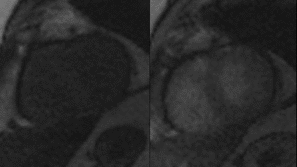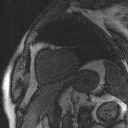Dynamic contrast MR myocardial perfusion imaging has evolved into an accurate technique for the diagnosis of coronary artery disease. T1-weighted images are rapidly acquired every heartbeat to track the uptake and washout of a contrast agent (see the animations). The diagnosis is based on time-series signal intensity data typically from rest and pharmacological stress. Quantification of myocardial perfusion can be a useful adjunct to visual analysis, and can be valuable in other contexts. To quantify the time-series data, motion-free data is desired.

However, at least 40 seconds of data are typically used to obtain regional perfusion values in the myocardium. Breath-holding becomes a major issue, particularly for patients and during pharmacological stress imaging. The problem is then to handle the inter-frame motion artefact caused by respiration, which makes quantitative analyses difficult.
At STACOM 2014, we organised a challenge for any research group to develop and/or test motion correction algorithms on a common dataset. Particularly, we are interested to test the hypothesis that there is no significant differences in terms of perfusion values from MR images that have been corrected either by non-rigid or rigid methods.
Participants
Below is a list of participants of the challenge. You can read more from [Pontre et al. 2017].
- Deformable and Rigid Model-Based Image Registration for Quantitative Cardiac Perfusion
D. Likhite, G. Adluru, E. DiBella - Advanced Normalization Tools for Cardiac Motion Correction
N.J. Tustison, Y. Yang, M. Salerno - Deformable Image Registration and Intensity Correction of Cardiac Perfusion MRI
M. Ebrahimi, S. Kulaseharan - Comparison of Linear and Non-linear 2D+T Registration Methods for DE-MRI Cardiac Perfusion Studies
G. Wollny, M.-J. Ledesma-Carbayo - Motion Correction for Dynamic Contrast-Enhanced CMR Perfusion Images Using a Consecutive Finite Element Model Warping
N. Noorman, J. Small, A. Suinesiaputra, B. Cowan, A.A. Young - Automatic Perfusion Analysis Using Phase-Based Registration and Object-Based Image Analysis
L. Tautz, T. Chitiboi, A. Hennemuth
Data
 The dataset consists of 10 cases from two centres: the University of Utah and University of Auckland. For each case, a single short axis slice time series at rest and at stress is provided. The Utah datasets were acquired using a saturation-recovery radial turboFLASH sequence at rest and during adenosine infusion (140 μg/kg/min), as described in (DiBella et al. 2012). Contrast was 5 cc/s injection of Multihance (Gd-BOPTA) at 0.02 mmol/kg for the rest and 0.03 mmol/kg for the stress. Four of these subjects have known coronary artery disease. The Auckland cases were acquired using a saturation-recovery Cartesian turboFLASH sequence at rest and during adenosine infusion (140 μg/kg/min). Contrast was 0.04 mmol/kg Omniscan (gadodiamide). None of the Auckland cases have overt coronary disease
The dataset consists of 10 cases from two centres: the University of Utah and University of Auckland. For each case, a single short axis slice time series at rest and at stress is provided. The Utah datasets were acquired using a saturation-recovery radial turboFLASH sequence at rest and during adenosine infusion (140 μg/kg/min), as described in (DiBella et al. 2012). Contrast was 5 cc/s injection of Multihance (Gd-BOPTA) at 0.02 mmol/kg for the rest and 0.03 mmol/kg for the stress. Four of these subjects have known coronary artery disease. The Auckland cases were acquired using a saturation-recovery Cartesian turboFLASH sequence at rest and during adenosine infusion (140 μg/kg/min). Contrast was 0.04 mmol/kg Omniscan (gadodiamide). None of the Auckland cases have overt coronary disease
Expert-drawn contours only at a reference frame, chosen when contrast is present in both ventricles, will be given to the participants. This will create the same starting point for everyone, and will remove any bias due to the initial contours.
Acknowledgment
If you are using the data for publication, please kindly cite the data source to the following paper:
B. Pontre, B.R. Cowan, E. DiBella, S. Kulaseharan, D. Likhite, N. Noorman, L. Tautz, N. Tustison, G. Wollny, A.A. Young, and A. Suinesiaputra, "An Open Benchmark Challenge for Motion Correction of Myocardial Perfusion MRI”, IEEE J Biomed Health Inform., 2017 Sep;21(5):1315-1326.
Data contributors
- Edward DiBella - University of Utah, USA
- Alistair Young - King's College London, UK